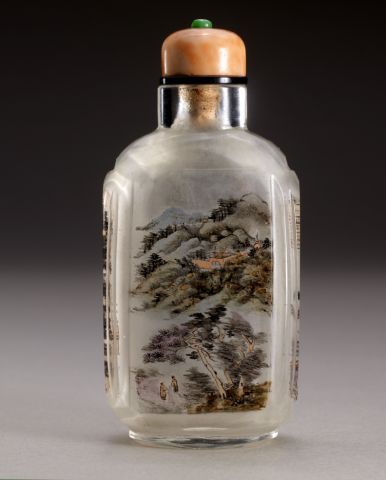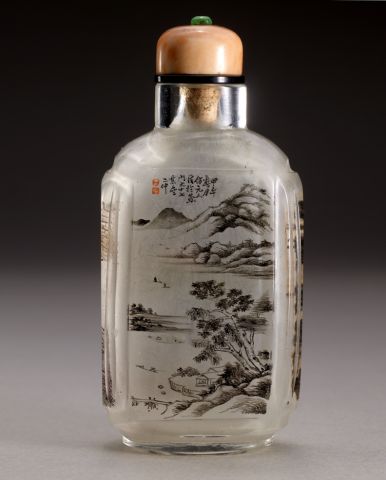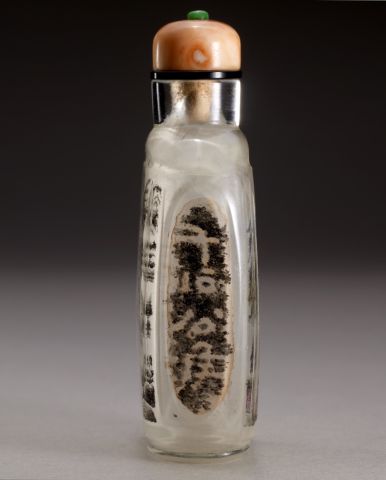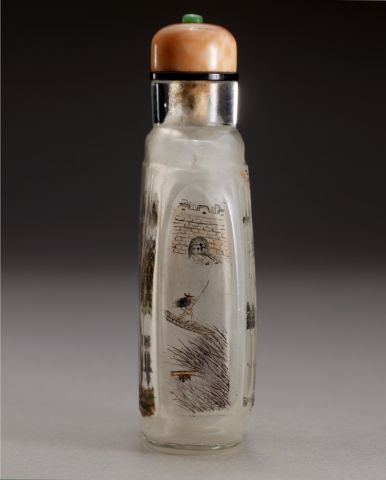



Bottle ID: 00689
DING ERZHONG, FIGURES IN MOUNTAINOUS LANDSCAPES & INSCRIPTION
Date: 1894
Height: 68 mm
Glass, ink and watercolors, of flattened rectangular form with rectangular panels on each side, painted on the inside with, on one main fascia en grisaille, a pine tree-filled mountainous landscape with a meandering river with sampans and fishermen on the water; beneath an inscription reading:
'A month in the spring of the jiawu year, emulating the painting method of the Yuan artists at the Studio of the Seventeen Prunus Trees, Gate of Yan'
Signed 'Erzhong' and with two red seals, Ding.
The reverse with two figures in conversation in a mountainous landscape with pavilions nestled amidst the hills; on one vertical side panel an archaic calligraphic inscription in negative 'bronze script'; the other vertical side panel with a boatman on a river overlooked by a fortress, paddling his sampan towards marshy reeds.
Similar Examples:
Moss, Hugh, Victor Graham and Ka Bo Tsang. A Treasury of Chinese Snuff Bottles - The Mary and George Bloch Collection, 2000, Vol. 4, Part 1, pp. 274-275, no. 539.
Hui, Humphrey K. F., Lai Suk Yee and Peter Y. K. Lam. Inkplay in Microcosm - Inside-painted Chinese Snuff Bottles, The Humphrey K. F. Hui Collection, 2002, no. 24.
Sotheby's, Hong Kong, October 30, 2000, lot 640.
Provenance:
Asian Art Studio
Albert Combatalade, California
Ed Combatalade
Exhibited:
Annual Convention ICSBS Toronto, October 2007
Sun Xun in "The Seal Art of the Republic" lists Ding Erzhong with his personal name of Ding Shangyu, as being from Shaoqing in Zhejiang province. It appears from the inscriptions on some of Ding's earlier bottles that he was painting in Xuannan, Beijing and using the studio name of the 'Seventeen Prunus Trees Mountain Retreat'. However, it seems that around 1898 or 1900, he moved to Nanjing. One publication states that after his father's death, he moved there with his mother, to live with his uncle. Since Ding was born in 1865, he would have been over thirty at this point. One other curious point, is that he seemed to have used his studio name both in Beijing and in Nanjing, although it was more usual for artists to change their studio names in different locations.
During his working period, Ding used two different studio names, the one given above of the 'Seventeen Prunus Trees Mountain Retreat' and another, the 'Iron Inkstone Studio' (Tieyan zhai). The latter is only used once in known bottles and as that bottle is undated, it is impossible to know other than by stylistic comparison when he painted it or where the 'Iron Inkstone Studio' may have been.
Ding Erzhong was not only a painter of bottles. He was a well-known seal carver in Nanjing, a painter, a carver of bamboo fans, inkstones and other scholar's desk objects. His working period in snuff bottles appears to be from 1892 until 1927, although there is one bottle which is wrongly dated to after he died. The majority of his recorded dated bottles are from 1892 until 1908, with the years 1896-1899 being the most prolific. After 1908, only two dated bottles are recorded, one in 1914 and one in 1927. Of his known paintings, his working period seems to be from around 1918 to 1934, the year before he died. From the works of art such as seals, one can glean that he was carving seals during the 1920's. This would suggest that Ding, while being trained in the literati tradition, went from painting inside bottles to scroll and album painting. It was during this second period that he was also carving seals and other pieces. Although there are twenty-one recorded bottles which are undated, it is likely that these are randomly spaced through the years rather than being concentrated in the period when there were no recorded dated bottles.
Ding Erzhong signed his pieces with the same names for bottles, paintings and works of art indicating that he valued his painting inside bottles on an equal footing as the other mediums. His known signatures are: Ding Erzhong, Erzhong, Erzhong di (younger brother) Ding Shangyu and Shang Erzhong yu. His seals are recorded as follows: Ding, Erzhong, Zhong, Erzhong yin, Yin and Taigu (extreme antiquity).
Although Ding was previously promoted as a non-commercial literatus who dabbled in inside painted bottles for leisure or to give away to his friends, this is clearly not the case. This does not denigrate his work in any way as his painting in bottles is of a stature only reached occasionally by other artists in this medium. The attributions he gives in the inscriptions to different painting styles show that he was well educated in all aspects of painting and had studied the masters from the Tang Period right up to and including his own contemporaries. He could as easily copy the Yuan painters, such as Dan Qiusang, as the Yangzhou Eccentrics such as Bian Shoumin.
In addition, Ding was a skilled calligrapher with knowledge of the ancient texts, for example on a bottle dated 1902, he inscribes an excerpt from zui weng ting, the 'Record of the Drunken Old Man Pavilion' by Ouyang Xiu of the Song Period. Ding's brush-strokes range from free and powerful to immaculate and detailed. On the Crane bottle, Ding uses negative "bronze script" which is essentially copied from rubbings of bronze vessels. On one of his couplets on a scroll dated to 1918, Ding inscribes that he has copied the couplet in "bronze script" from his own collection of bronzes kept in Nanjing (presumably at his home).
Interestingly, the most similar snuff bottle to the Crane example is in Hui and Lam "Inkplay in Microcosm" where Ding has painted a very similar archaic inscription and a scene of a boatman. Ding inscribes that this was after the style of the Yuan painter Wu Zhen (1280-1354), who was one of the Four Masters, renowned for his depiction of fishermen. The Hui bottle is dated to 1893, the second year of Ding's known working period, when he painted four bottles, while the Crane bottle is dated to the following year 1894, and is one of only three recorded bottles from that year.
< Back to full list
 English
English 中文
中文